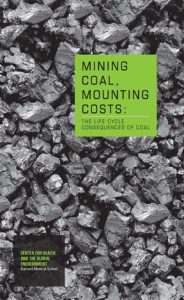Harvard Medical School: Using coal costs the U.S. hundreds of billions of dollars a year in health costs, environmental destruction and climate change

The report, published this month in the Annals of the New York Academy of Sciences, is based on the first detailed life cycle analysis study of coal, from mining through combustion. A summary has been published as a brochure, Mining Coal , Mounting Costs: The Life Cycle Consequences of Coal.
“We estimate that the life cycle impacts of coal and the waste stream generated are costing the U.S. public a third to over one half a trillion dollars annually. Accounting for the damages conservatively doubles to triples the price of electricity from coal per kWh generated, making wind, solar, and other forms of non-fossil fuel power generation, along with investments in efficiency and electricity conservation methods, economically competitive.
“Beyond dollar evaluations, qualitative impacts include harm to air quality, watersheds, land, plants, animals, families and communities. The proposed technology of CCS is costly and risky, and is projected to magnify the ecological and health footprint of coal.”
The study estimates a range of total costs at between $175 Billion and $523 Billion. The best (mid-range) estimates of major costs are:
- Land Disturbance: Carbon & Methane: $2.3B
- Public Health Burden in Appalachian Communities: $74.6B
- Fatalities Due to Rail Transport: $1.8B
- Air Pollutants from Combustion: $187.5B
- Mercury Impacts: $5.5B
- Subsidies: $3.2B
- Abandoned Mine Lands: $8.8B
- Climate Change from Combustion: $61.7B
- Total: $345B
The study concudes:
“Still these figures do not represent the full societal and environmental burden of coal. In quantifying the damages, we have omitted the impacts of toxic chemicals and heavy metals on ecological systems and diverse plants and animals; some ill-health endpoints (morbidity) aside from mortality related to air pollutants released through coal combustion that are still not captured; the direct risks and hazards posed by sludge, slurry, and CCW impoundments; the full contributions of nitrogen deposition to eutrophication of fresh and coastal sea water; the prolonged impacts of acid rain and acid mine drainage; many of the long-term impacts on the physical and mental health of those living in coal-field regions and nearby MTR sites; some of the health impacts and climate forcing due to increased tropospheric ozone formation; and the full assessment of impacts due to an increasingly unstable climate.
“The true ecological and health costs of coal are thus far greater than the numbers suggest. Accounting for the many external costs over the life cycle for coal-derived electricity conservatively doubles to triples the price of coal per kWh of electricity generated.”
+++++++++++++
Some summary statistics on the importance of coal:
- Coal accounted for 25% of global energy consumption in 2005, but generated 41% of the CO2 emissions that year.
- In the United States, coal produces just over 50% of the electricity, but generates over 80% of the CO2 emissions from the utility sector.
- Coal burning produces one and a half times more CO2 emissions than does burning oil and twice that from burning natural gas (to produce an equal amount of energy).
- The energy penalty from CCS (25–40%) would increase the amount of coal mined, transported, processed, and combusted, and the waste generated.
- Today, 70% of rail traffic in the United States is dedicated to shipping coal. Land and transport would be further stressed with greater dependence on coal.



Some humans, perhaps the majority, are fatally attracted to ‘quick money’. Up until the present, because many of the associated costs were externalised, quick money has come from the exploitation of natural resources.
Coal is one such resource and gold is another. Both have been and continue to be heavily exploited in my country South Africa. On the Witwatersrand, where I live, we are facing a water crisis because of acid mine drainage. It comes from the gold mines, many now worked out and the miners having gone there is no need to keep them dry. Consequently the mines are becoming flooded. The rocks which in their unmined state would never have been exposed to water are now leaching all sorts of salts into this flood water and as the water levels in the mines rise this acidified water is beginning to decant into the untainted water table. We have what geologists call three basins in which gold was and is mined. The decanting in the western basin has already destroyed the life in river systems there and a similar thing will shortly start to happen in the central and eastern basins. Luckily government, somewhat late in the day, is mounting a massive effort to try to prevent the same thing happening in the central and eastern basins. The miners meanwhile have pocketed their quick money.